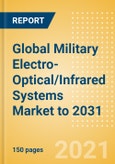The global military electro-optical/infrared (EO/IR) systems market is valued at US$9.2 billion in 2021 and is anticipated to increase at a CAGR of 3.43% to reach a value of US$12.9 billion by 2031. The cumulative market for global EO/IR systems is estimated to value US$119.6 billion over the forecast period. The demand for EO/IR systems is anticipated to be driven by the increased need for battlespace awareness by defense forces and technological advancements to improve effectiveness of EO/IR systems.
The integration of technologically advanced EO/IR systems into modern warfare platforms to obtain information superiority and situational awareness is expected to be a major factor driving the expenditure in this sector. This trend is further supported by increasing investments by major militaries in targeting systems, high resolution payloads, and other systems.
Research in the field of third-generation forward-looking infrared, nonlinear crystals, laser radars, advanced 3D visualization, persistent surveillance systems, multispectral and hyperspectral sensors, is leading to the creation of more capable EO/IR systems. The EO/IR market is seeing demand from man-portable and airborne platforms, leading to sustained investment in both the segments.
The US is the leader in the research and development of military EO/IR systems and related technologies and is currently conducting several test programs and experiments in this sphere.
The integration of technologically advanced EO/IR systems into modern warfare platforms to obtain information superiority and situational awareness is expected to be a major factor driving the expenditure in this sector. This trend is further supported by increasing investments by major militaries in targeting systems, high resolution payloads, and other systems.
Research in the field of third-generation forward-looking infrared, nonlinear crystals, laser radars, advanced 3D visualization, persistent surveillance systems, multispectral and hyperspectral sensors, is leading to the creation of more capable EO/IR systems. The EO/IR market is seeing demand from man-portable and airborne platforms, leading to sustained investment in both the segments.
The US is the leader in the research and development of military EO/IR systems and related technologies and is currently conducting several test programs and experiments in this sphere.
Key Highlights
- The global military electro-optical/infrared (EO/IR) systems market is expected to grow at a CAGR of 3.43% over the forecast period.
- The global military electro-optical/infrared (EO/IR) systems market is classified across various categories; Platform-Based, Man-Portable and Stationary.
- The global military electro-optical/infrared (EO/IR) systems market is expected to be led by North America with a revenue share of 44.3%. The region's significant share is primarily due to high demand from the US Armed Forces for EO/IR systems. The increasing funding from the US government for R&D activities and domestic demand from the military are key contributors to the US market for military EO/IR systems.
- Man-Portable EO/IR is expected to be the largest segment of the EO/IR Systems market over the forecast period.
Who Should Buy
- Defence Startup's, Original Equipment Manufacturers (OEMs), Defence Planners, Venture Capital Firms, Government Agencies, Head of Marketing, Head of Sales, CEOs and Senior Executives.
- The concerned stakeholders can utilize the report to identify high growth segments and customize their offerings to match the project requirements.
- The Venture Capital Firms can utilize the project details, growth rate, and market size to identify and fund high potential startups.
Scope
In particular, the report provides an in-depth analysis of the following:
- Market size and drivers: Detailed analysis during 2021-2031, including highlights of the demand drivers and growth. It also provides a snapshot of the spending and modernization patterns of different regions around the world.
- Recent developments and industry challenges: Insights into technological developments and a detailed analysis of the existing EO/IR Systems projects being executed and planned worldwide. It also provides trends of the changing industry structure and the challenges faced by industry participants.
- Regional highlights: study of the key markets in each region, providing an analysis of the key segments of the market that are expected to be in demand.
- Major programs: details of the key programs in each segment, which are expected to be executed during 2021-2031.
- Competitive landscape and strategic insights: analysis of the competitive landscape of the global EO/IR Systems market. It provides an overview of key players, their strategic initiatives, and financial analysis.
Reasons to Buy
- Determine prospective investment areas based on a detailed trend analysis of the global military electro-optical/infrared (EO/IR) systems over the next ten years
- Gain in-depth understanding about the underlying factors driving demand for different EO/IR Systems segments in the top spending countries across the world and identify the opportunities offered by each of them
- Strengthen your understanding of the market in terms of demand drivers, industry trends, and the latest technological developments, among others
- Identify the major channels that are driving the global EO/IR Systems market, providing a clear picture about future opportunities that can be tapped, resulting in revenue expansion
- Channelize resources by focusing on the ongoing programs that are being undertaken by the defense ministries of different countries within the global EO/IR Systems market
- Make correct business decisions based on in-depth analysis of the competitive landscape consisting of detailed profiles of the top EO/IR Systems providers around the world. The company profiles also includes information about the key products, alliances, recent contract awarded, and financial analysis, wherever available
Table of Contents
- Executive Summary
- Global Military EO/IR Systems Market - Overview
- Market Dynamics
- Global Military EO/IR Systems Market - Segment Analysis
- Global Military EO/IR Systems Market - Regional Analysis
- Global Military EO/IR Systems Market - Trend Analysis
- Key Programs Analysis
- Competitive Landscape Analysis
- Appendix
Companies Mentioned (Partial List)
A selection of companies mentioned in this report includes, but is not limited to:
- Microsoft Corp
- Lockheed Martin Corp
- Raytheon Technologies Corp
- Theon Sensors SA
- L3 Harris Technologies Inc
- Leonardo SpA
- Northrop Grumman
- Safran SA
- Elbit Systems Ltd
- Teledyne Technologies Inc








